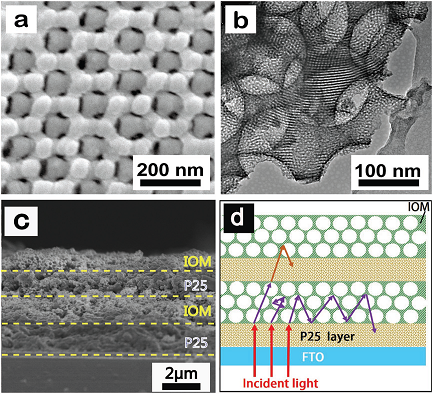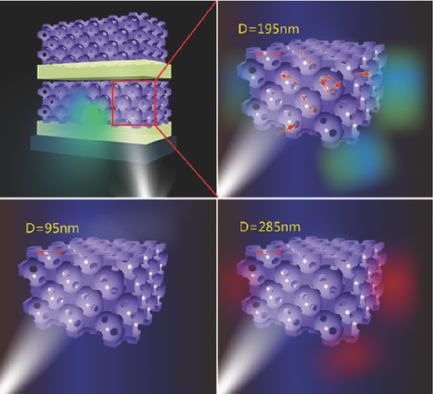In order to solve the problems of energy shortage and environmental pollution, effective utilization of solar energy has become paramount important. As the energy density of sunlight is low and asymmetrical, maximizing sunlight harvesting and absorbing efficiency is vital for effective solar energy conversion. The utilization of sunlight with different wavelength is highly dependent on both compositional and structural properties of materials.
Inverse opal structure (IO) with periodic macropore could be used as an effective light scattering layer because of the standing wave effect. However, single IO structure inevitably decreases the absorption of active substance due to the relatively small specific surface area. In 2011, the research team led by Prof. WANG Dan at Institute of Process Engineering (IPE), Chinese Academy of Sciences (CAS) had successfully produced a type of IO structure with ordered mesoporous (IOM), which promotes the photodegradation activity significantly due to the bi-functional properties of dually ordered meso- and macro-pore structures. Nevertheless, it is still a challenge to precisely control the response wavelength, reflection, and scattering abilities of IOM.
Recently, researchers further investigate the light propagation behavior of IOM with different macropore diameters by finite-difference time-domain simulations. Calculation results show that IOM with macropore size of 195 nm presents the best reflection within the wavelength region of 400-600 nm, and IOM with macroporous size of 285 nm presents the best reflection within the wavelength region of 300-400 nm. The experimental results demonstrate that photoanodes fabricated by IOM with macroporous size of 195 nm on top of P25 films result in a dramatically improved photoelectric conversion efficiency up to 9.2%, much higher than that of P25 photoanodes without IOM (6.57%). This due to that N719 dye has abundant absorption of light in the range of 400-600 nm. And the IOM-195 can effectively reflect light within this region to increase the light harvesting efficiency of the dye. Correspondingly, IOM with macroporous size of 285 nm shows the worst performance in hydrogen evolution reaction, which is due to that TiO2 can only utilize the ultraviolet fraction of solar spectrum and the most of which can be reflected by IOM-285, resulting in less light being absorbed. The obtained results confirm that the light reflection can be accurately manipulated by precisely controlled synthesis of macroporous sizes of IOM, demonstrating a new means to design and fabricate high-performance solar energy conversion devices.


(Images by WANG Dan)
Figure 1. a) A typical top view SEM image, b) TEM image, and c) Crosssectional SEM image of QTiMMFs. d) Schematic illustration of QTiMMFs and light pathways within the film.
Figure 2. Schematic illustration of light propagation behavior of IOM with different macropore diameters.
The research team includes a group led by Prof. WANG Dan from IPE, CAS, a group led by YU Ranbo from University of Science & Technology Beijing, and a group led by ZHAO Huijun from Griffith University. The collaborators provided theoretical calculation to their work. The research was supported by the National Natural Science Foundation of China (21590795, 21201167), National Science Fund for Distinguished Young Scholars (21325105), CAS Interdisciplinary Innovation Team, and et al.
Their work entitled “Dually ordered porous TiO2-rGO composites with controllable light absorption properties for efficient solar energy conversion” has been published in Adv. Mater, (2016, DOI: 10.1002/adma.201604795).
http://onlinelibrary.wiley.com/doi/10.1002/adma.201604795/full
Contact:
Prof. WANG Dan
State Key Laboratory of Biochemical Engineering, Institute of Process Engineering, Chinese Academy of Sciences, Beijing 100190, P. R. China.
E-mail: danwang@ipe.ac.cn
|
|
|
 Search
Search




 京公网安备110402500047号
京公网安备110402500047号